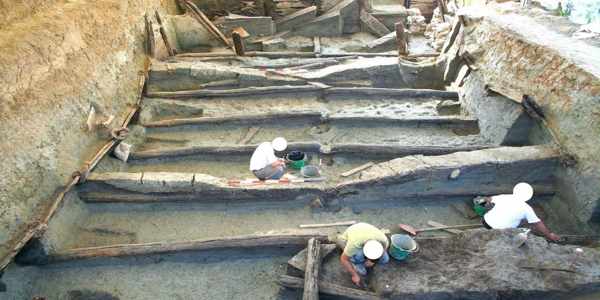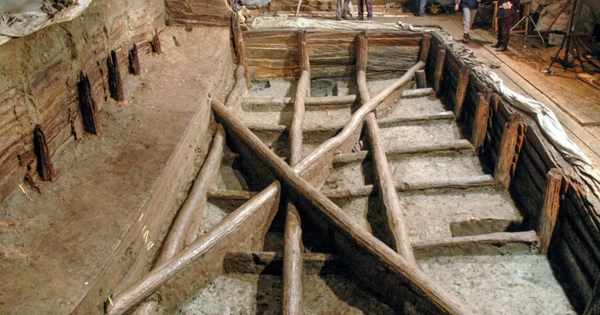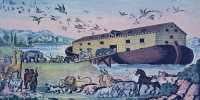The Noceto Vasca Votiva is a one-of-a-kind wood structure discovered in 2005 on a small hill in northern Italy. The in-ground structure, constructed primarily of oak and slightly larger than a backyard swimming pool, has remained a mystery, as has the date of its construction. Its origins, according to Italian researchers, date back to the late Middle Bronze Age, between 1600 and 1300 B.C.
While the difference may not appear to be significant, in archeological terms, it is equivalent to comparing the culture that invented the steam engine to the one that produced the iPad.
A Cornell University team led by Sturt Manning, Distinguished Professor of Arts and Sciences in Classics and director of the Tree-Ring Laboratory, used dendrochronology and a type of radiocarbon dating known as “wiggle-matching” to pinpoint the years when the structure’s two main components were built: a lower tank in 1444 B.C. and an upper tank in 1432 B.C. Each date has a four-year margin of error.
The discovery confirms that the Noceto Vasca Votiva was constructed at a critical societal juncture and supports the Italian researchers’ theory that the structure was used for a supernatural water ritual.
A team used dendrochronology and a form of radiocarbon dating called ‘wiggle-matching’ to pinpoint, with 95% probability, the years in which an ancient wooden structure’s two main components were created: a lower tank in 1444 B.C., and an upper tank in 1432 B.C.
The team’s paper, “Dating the Noceto Vasca Votiva, a Unique Wooden Structure of the 15th Century BCE, and the Timing of a Major Societal Change in the Bronze Age of Northern Italy,” was published in PLOS ONE.
Since 2006, Manning has led the Tree-Ring Laboratory, and his team has developed a variety of tools and techniques that have successfully challenged common assumptions about historical artifacts and timelines. Among the lab’s specialties is tree-ring sequenced radiocarbon “wiggle-matching,” which involves dating ancient wooden objects by matching the patterns of radiocarbon isotopes from their annual growth increments (i.e., tree rings) with patterns from datasets found elsewhere around the world. This allows for ultra-accurate dating even when a continuous tree-ring sequence for a specific species and geographic area is not yet available.
“When working at an archaeological site, you’re frequently trying to do dendrochronology with a small number of samples, which are often in less-than-ideal condition because they’ve been falling apart for the last 3,500 years before you get to see them. It’s not like there’s a healthy tree growing in the wild right now “Manning explained. “We frequently measure the samples multiple times to extract as much signal as possible.”

The Noceto Vasca Votiva is about 12 meters long, 7 meters across, and four meters deep – though the depth was initially a little ambiguous. When the site was fully excavated, the researchers discovered a second tank beneath the structure, which had been built first but collapsed before it was finished. It wasn’t clear how much time had passed between the creation of the two tanks, which used some of the same materials.
The Italian researchers recognized that the Noceto Vasca Votiva was a major undertaking for its era and theorized its purpose based on the size of the structure and the extensive labor that would have been required to excavate the earth and drag timber to the uphill location. However, they were unable to determine the precise date of its origins and turned to the Cornell Tree-Ring Laboratory for assistance.
Manning’s team tried several times with different samples. While the wood from the Noceto site was well-preserved – a rarity given its age – the samples did not appear to fit the international radiocarbon calibration curve that is used to match tree-ring sequences. This indicated that the curve needed to be revised for specific time periods, and a new version was published in 2020. Finally, the Noceto data fit.
The Cornell team was able to establish a tree-ring record that spanned several hundred years by combining radiocarbon dating calibrated via dendrochronologies from southern Germany, Ireland, and North America with computer-intensive statistics. They dated the construction of the lower and upper tanks to 1444 and 1432 B.C., respectively, and determined that the finished structure was in use for several decades before being abandoned for unknown reasons.
The new timeline is especially significant because it corresponds to a period of tremendous change in Italian prehistory. “You’ve had one way of life for hundreds of years, and then there appears to be a shift to fewer, larger settlements, more international trade, more specialization, such as textile manufacturing, and a change in burial practices,” Manning explained.
“There is a pattern that can be found all over the world. Almost every time there is a major change in social organization, there is an episode of what could be described as unnecessary monuments being built. So, when Egypt’s first states emerge, the pyramids appear. Stonehenge represents a significant shift in southern England. Noceto is not on the same scale as Stonehenge, but it is an act of major place-making.”
The structure was not used as a reservoir or well because it was located on a hill rather than in the center of a village. The smooth layers of sediment that filled in the structure, as well as the lack of channels, indicate that it was not used for irrigation. Furthermore, the researchers discovered a large collection of objects that had been purposefully deposited inside the tank, including numerous ceramic vessels, figurines, and a variety of stone, wood, and organic items. All of this evidence suggests that the structure was used in some sort of supernatural water ritual.
“It’s tempting to think it was about making a reflective surface that you can see into and put some offerings on, but you’re also looking at the sky above and the linking of land, sky, and water (rain),” Manning explained.
“The collapse of the entire social and economic system appears to occur around 1200 B.C. because it becomes much drier,” Manning explained. The Italian Ministry of Education, University, and Research funded the study.















